Types of Support And Reaction | What Is Support | What Is Reaction In Structure | Fixed Support | Hinge Support | Roller Support
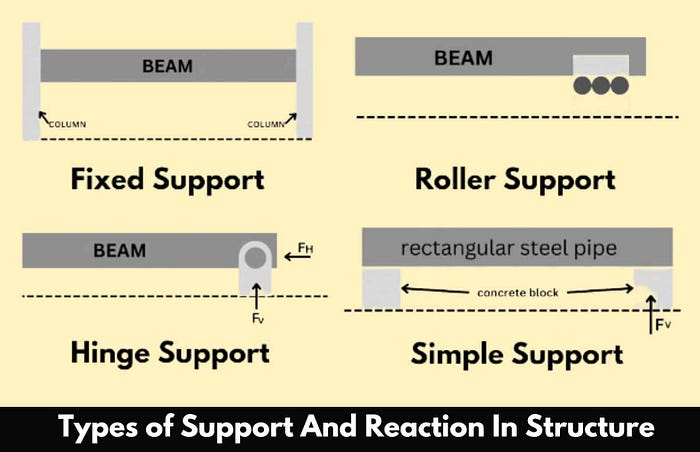
The topic “Support and reaction” is the base for structural analysis. If we want to find the reaction at the end of the beam then we must know which support it is and how many reactions are there. so in this article, we will show you types of support and reaction and how to calculate them.
What Is Support?
In simple words, support is a component that bears a whole load of more above structure and passes that load on its own, and Support will try to hold the structure to keep the structure in safe and stable condition.
Support resists the movement of components in some particular direction which occurs due to external forces. and results in resistant force. In this concept, there are two important terms which are force and moment.
What Is Reaction?
The reaction is force, which generates the response of external forces on the structure. When a particular structural component restrains some movement at that time in the opposite direction of force, reaction force generates.

Reaction Force
for example, when we put a concrete block on the land, then the land will resist its load. and load always works in the vertical direction.
because it restricts the vertical direction movement of that block there will be a vertical reaction force generated in the opposite direction of force W.
In the second example, here we set one piece of paper in the air and put that same concrete block on that paper, what will happen? there will be no reaction force because the paper will not resist the weight of the block.
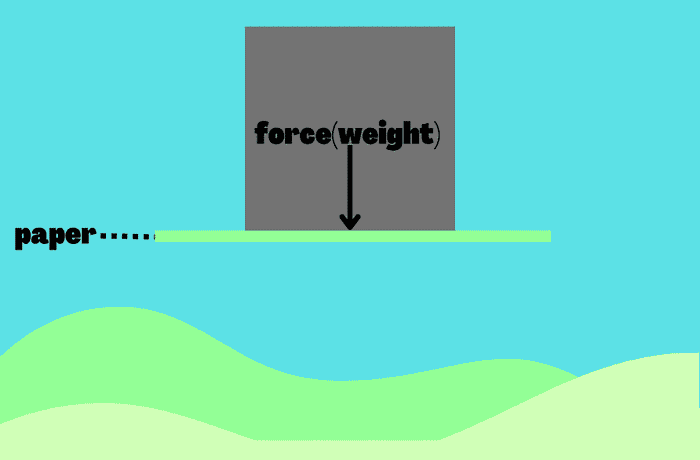
Force On Object
So, “the value of reaction is the same as a force but the direction is different.”
Types of Reaction Forces
There are three types of reaction forces that are produced as listed below.
1. Vertical reaction forces
2. Horizontal reaction force
3. Moment reaction
vertical reaction forces work in the vertical direction but in the opposite of the main forces. whereas horizontal reaction forces are also applied at the same value but in the opposite direction of the force. and moment reaction is all due to restriction in rotating.
How We Are Getting Support Reactions?
Every support allows some movement to structural components and restricts some movements at the same time.
When support retains the movement of the component due to external forces then reacting force will be produced at the support. and If it allows movement then there be no reaction appears.
Types of Support?
There are mainly three types of support that we are using in a regular structural system. and one more type of support is there which is the same as roller support, but that is not frequently used in the structure.
1. Hinged support
2. Fixed support
3. Roller support
4. Simple support
1. Hinged Support
To get more familiar with hinged support, Let’s consider a simply-supported beam that has both ends hinge.
The support is a hinge so it will allow rotational movement of the pan but will restrict horizontal and vertical movement of that component from the support.
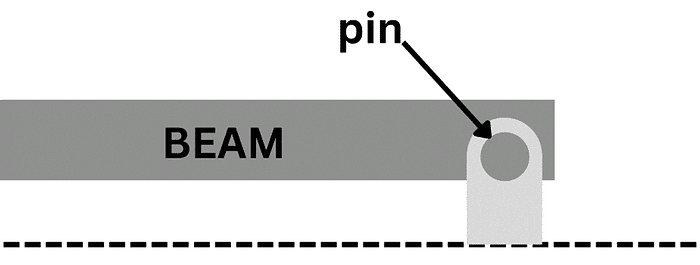
Hinged Support
So as per the above formula or we can say the thumb rule we can say that at both ends we get horizontal and vertical reactions because it restricts horizontal and vertical movement of that beam.
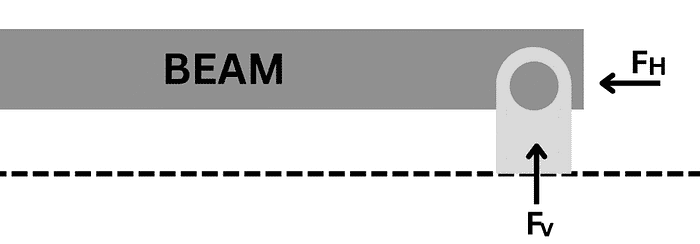
Hinged Support & Reaction
The best example we can take is a door. We can open and close the door from the hinge support. it is given with the wall, but we cannot change the door position and as well as horizontally.
Another example is a bridge.
2. Fixed Support
To understand Fixed support, let’s considered a beam that has both ends fixed. And because of both fixed support, it will restrict all the movement of the bean which is vertical horizontal, and rotation from both ends.
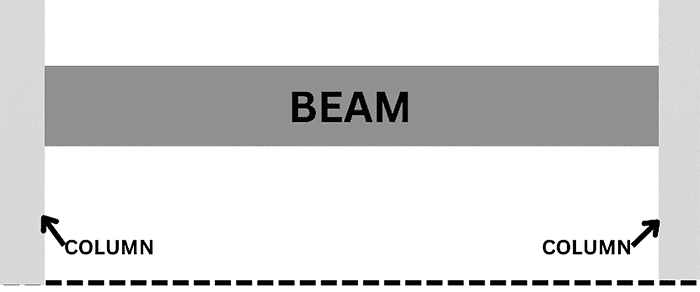
Fixed Support
so, there will be no movement in the vertical direction, horizontal direction as well as rotation. because of that at the end of support, there will be three reactions generated which are horizontal reaction, vertical reaction, and moment.
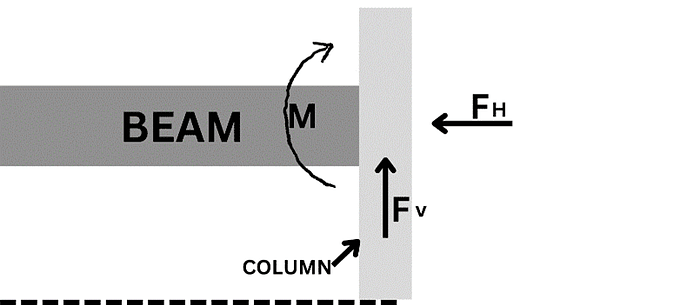
Fixed Support and Reaction
The best example of this support is considered a beam that is connected to both ends with a column so there will be no vertical as well as horizontal movement and no rotation. you can find this type of joint in your home.
3. Roller Support
Here let’s take a simply supported beam, where one is hinged support and another end is roller support.

Roller Support
So one end is roller support, the beam will easily move in the horizontal direction as well as support will allow the beam to rotate but it restricts the movement in the vertical direction.
On another end, as mentioned above we provide hinge support, so we know that hinge support allows only a moment.
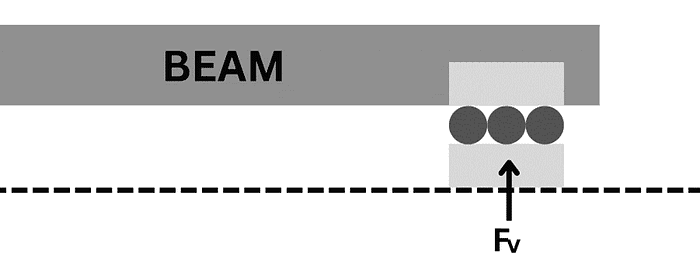
Roller Support And Reaction
So at that point, we will get two reactions, one is horizontal, and the second one is vertical reactions.
This type of support and reaction is mainly used in bridges. Where due to the vibration and expansion effect we need to provide support that allows horizontal and moment but restricts vertical movement.
4. Simple Support
As simple support is just similar to rolling support. we consider the main types of support to are fixed support, roller support, and hinged support. but we do not consider simple support as the main type.

Simple Support
In general building construction, we cannot consider simply support very often.
Simply support is support that restricts the horizontal movement of the component so it generates a vertical reaction just like roller support.
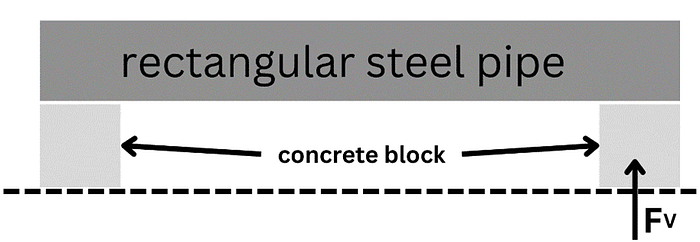
Simple Support and Reaction
And the best example of simple support and reaction is when we put rectangular steel pipe on two concrete blocks.
Read More: What Is A Coffered Ceiling | Top 3 Types of Coffered Ceiling | Styles of Coffered Ceiling
How To Find The Number of Reactions In The Beam?
To find the number of reactions in the beam we need to which support type is used and which reactions are prevented by that support.
Let’s take an example,
Example:-1
As per the below figure, where both ends are fixed.

Example of Fixed Support
due to both ends being fixed, there is no movement allowance in the beam. so the number of reactions at each end is 3.
So, the total number of reactions is 6 (each end has 3 so, a total of 6)
Example:-2
As per the below figure, one end is roller support and another end is hinged support.
because one end is roller support, roller support restricts vertical forces and due to that vertical reaction forces are generated.

Example of Hinged Support
Another end is hinged support, hinged support restricts vertical and horizontal movement but allows rotation. so the resultant reactions are horizontal and vertical.
so the total number of reactions is 3(1 reaction force is due to roller support and 2 reaction forces act due to hinged support)
Example:-3
As per the below figure, one end is fixed support and another end is hinged support.
because one end is fixed support, fixed support restricts all movements and due to that vertical reaction, horizontal reaction, and moment are generated.

Example of Roller Support
Another end is hinged support, hinged support restricts vertical and horizontal movement but allows rotation. so the resultant reactions are horizontal and vertical.
so the total number of reactions is 5(3 reaction force is due to fixed support and 2 reaction forces act due to hinged support).
FAQs:
What Is Support?In simple words, support is a component that bears a whole load of more above structure and passes that load on its own, and Support will try to hold the structure to keep the structure in safe and stable condition.What are the different types of support and reaction?1. Hinged support
2. Fixed support
3. Roller support
4. Simple support How we are getting support reactions?When support retains the movement of the component due to external forces then reacting force will be produced at the support. and If it allows movement then there be no reaction appears.
You May Also Like
- What Is A Cantilever Beam | Application of Cantilever Beam | Advantages and Disadvantages of Cativer Beams
- 15 Different Types of Plywood | What Is Plywood and Their Types | 15 Best Types of Plywood for Furniture
- What Is A Coffered Ceiling | Top 3 Types of Coffered Ceiling | Styles of Coffered Ceiling
- 40 Types of Bridges | Classification of Bridges | 40 Different Types of Bridges Used In The World
- 21 Different Types Of Arches In Construction
- Types of Walls | Interior Walls Types | Types of Wall Materials | Types of Internal Walls | Types of Walls In Homes
